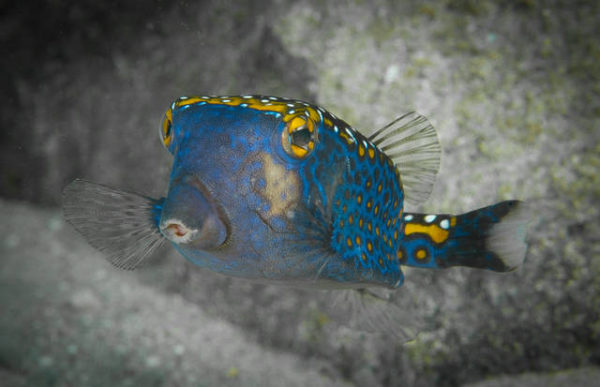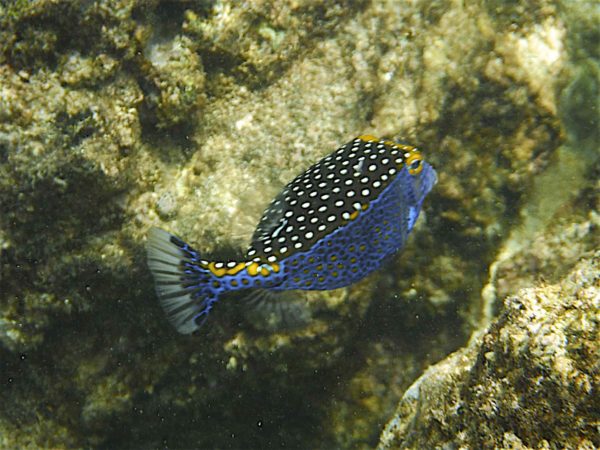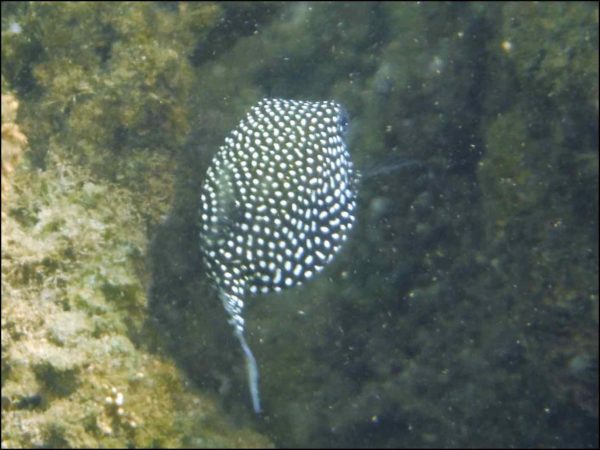Published in the Ocean Watch column, Honolulu Star-Advertiser © Susan Scott
September 23, 2017
My 10-year-old snorkeling friend Darius shouted, “I see a pufferfish!”
He pointed as we swam at Three Tables, part of the Pupukea Marine Life Conservation District.
I looked at the fish.
“That’s called a trunkfish,” I told him.
 Boxfish are named for their rectangular shape, formed
Boxfish are named for their rectangular shape, formed
by a rigid shell around the body. Only the fishes’ eyes, fins,
mouths and tail are movable. Boxfish ooze a poison to ward off predators.
Courtesy Russell Gilbert
But neither of us was entirely right, nor was either of us entirely wrong. The swimming suitcase I called a trunkfish gets the heading “Boxfishes and Cowfishes” in my fish textbook, but adds in parentheses, “Also called trunkfish.”
And Darius wasn’t far off in calling the slow-swimming fish a pufferfish. Trunkfish and pufferfish aren’t from the same family, but they’re kissing cousins.
No fish, though, wants a kiss from a boxfish. Like its pufferfish kin, boxfish carry a toxin so strong it can kill aquarium mates. And if the little boxfish gets really upset, it can exude, from its skin, enough poison in the tank to also kill itself.
Clearly, boxfish didn’t evolve to live in bowls. In the ocean the boxfish’s slippery toxin repels predators but dilutes fast enough in open water to keep the boxfish unharmed.
Boxfish poison isn’t known to kill humans, as does pufferfish poison, but still, I wouldn’t try licking one. Although some people in Asia eat boxfish, the soapy substance the fish ooze is similar to detergent.
Like pufferfish, blue-ringed octopuses, poison arrow frogs and others, boxfish hire out their chemical weapon production to bacteria. In this classic case of symbiosis, the bacteria get a place to hang their hats, and in return they manufacture sudsy slime to protect their host.
The name boxfish, and trunkfish, comes from the fishes’ rigid, rectangular shell, which covers the entire body like a knight’s armor. Only the fishes’ eyes, fins, mouths and tail are movable. A few bones support the fishes’ internal organs, but evolution has done away with most bones, including ribs.
Hawaii hosts two common species of trunkfish, the spotted boxfish and the thornback cowfish, growing 5 to 6 inches long. It seems as if there are more, because males and females of the same species look different.
The cowfish gets its name from forward-pointing “horns” on its head. When threatened, the cowfish swims backward, keeping its sharp horns facing the intruder. En guard!
Boxfish swim like little wind-up toys, propelling themselves around with amazing speed and dexterity using only side and rear fins. Members of this family eat algae, sponges, worms and small crustaceans.
I don’t fuss over animal names because, to me, as long as the person involved knows what the other person is talking about, well, the name did the job.
I’m looking forward to my next snorkeling excursion with Darius, hoping he spots another pufferfish-trunkfish-boxfish-cowfish. When you see a fish in shining armor, it’s always worth a shout.

